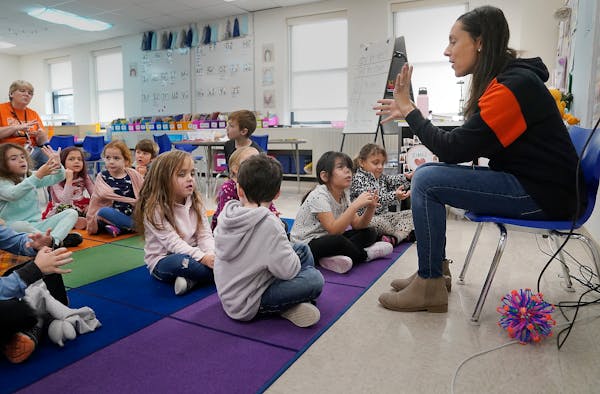ST. CLOUD — School leaders say they're tired of losing money to charter schools that prey on their enrollment and then return kids to district schools who often barely meet state reading and math requirements.
Because of this, the St. Cloud Area School District is asking the state for better accountability over charter schools. It also wants to be free from transportation requirements for charters that cost the district $1 million a year.
On Wednesday, St. Cloud's school board unanimously approved two resolutions for the Minnesota School Boards Association's conference later this year. The school board wants the MSBA to ask the Legislature to study and determine if charter schools are delivering on the intent of the original legislation, and to fully reimburse districts for transportation costs related to charter schools.
Minnesota is the birthplace of the charter school movement, with the first schools opening in 1992. Now, about 76,000 students are enrolled in 180 charter schools in the state. Because they are considered public schools, charters are tuition-free and open to all students, but they often are run by nonprofits authorized by the state to oversee the school's finances and monitor student achievement.
While a handful of Minnesota charters have received national acclaim, critics say the charter school experiment has failed to deliver.
"The real goal of the charter schools at that time was to create some laboratories for education," said Al Dahlgren, St. Cloud school board member who drafted the resolutions. "I think charter schools have a place ... and I think that we can learn from them, but I'm not so certain the proliferation of charter schools — unfettered — is beneficial to the education system."
There are four charter schools in St. Cloud's school district boundaries and two new charters are expected to open in the next few years. But the charters are failing in their primary purpose of improving student achievement, Dahlgren said.
The 2022 math proficiency rates for the charter schools in the district's boundaries ranged from 14% to 22% — below the district's proficiency rate of 28%, which is well below the statewide average of 42%.
The number of grades offered at each school differs, so the rates don't offer a direct comparison, but they do show a trend of lower proficiency, in general, at the charter schools, which serve students in elementary and middle grades.
The enrollment breakdown — based on race, whether a student lives in poverty, whether they are an English-learner and whether they qualify for special education — is different at each school and in each district, which likely accounts for some of the proficiency rate differences. None of the charter schools returned a request for comment Thursday.
Josh Crosson, executive director of EdAllies, said the fight between charter schools and districts detracts from the larger issue — that many kids are being failed by public schools. EdAllies is a Minnesota nonprofit that works to make sure every child in Minnesota has access to education, especially children of color. Crosson is also a board member of the Northeast College Prep charter school in Minneapolis.
"Many parents that I talk to who are attending charter schools, it's because they see an option to send their kid to an affirming place, whether that's culturally affirming [or] academically rigorous," he said.
Education innovation was the purpose of charter schools, Crosson said. Providing another option for students who weren't thriving in district schools was another purpose.
"There needed to be an outlet for parents and students to be able to explore different opportunities to learn," Crosson said.
At Wednesday's St. Cloud school board meeting, members said they are in favor of parent choice but are frustrated by the chaos created by last-minute changes related to charter schools. There is a pattern every October —that's when a number of parents decide to pull their kids back into district schools.
About 12% of St. Cloud school district students are enrolled in charter schools but that number fluctuates.
Superintendent Laurie Putnam said the October influx creates funding challenges because students often return to the district after the date that the state takes the official enrollment count. So while the district will receive a percentage of per-pupil funding when students transfer into the district, it does not receive additional compensatory funding for students who are eligible for free and reduced lunches; that extra funding is meant to meet the additional educational needs of students not at grade level.
"We end up serving students, which we are glad to do, but we serve the students for the majority of the school year but [without the additional] funding," Putnam said at an August board meeting. "It creates higher class sizes for us. None of us are looking for that."
The district is reimbursed for part of the cost to transport students to charter schools, but loses about $1 million a year because it costs more to bus charter students. That's because the law states the district must transport students from anywhere within the entire 250-square-mile district to the charter school of their choice, whereas district students are bussed to the school to which they are nearest.
Putnam said if the district weren't spending the $1 million to transport charter students, it could use that money to invest in about 11 licensed full-time employees, such as teachers or social workers.
The school board's resolutions ask the Legislature to consider creating a moratorium on new or expanded charters in saturated markets. The board is also asking the state to provide equitable funding and enforce charter accountability standards.
"Why create a new school and just transplant students from our district, taking funding away from the public school district and over to the charter school, if there's not going to be any real benefit to education for doing so?" Dahlgren asked. "It creates a lot of turmoil."
Crosson would rather see the conversation focus more on better serving kids.
"Frankly, what I think the St. Cloud public school is doing is trying to meet their own bottom line ... and not really centering on the concerns of parents and students directly," he said.

GOP endorses Tad Jude for congressional seat Dean Phillips is leaving
One day in the frantic life of a Children's Minnesota emergency room nurse
Sen. Nicole Mitchell off committee assignments while case under review


